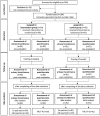Does trunk muscle training with an oscillating rod improve urinary incontinence after radical prostatectomy? A prospective randomized controlled trial
- PMID: 31858823
- PMCID: PMC7029439
- DOI: 10.1177/0269215519893096
Does trunk muscle training with an oscillating rod improve urinary incontinence after radical prostatectomy? A prospective randomized controlled trial
Abstract
Objective: To investigate the effect of a new therapeutic approach, using an oscillating rod to strength the pelvic floor and deep abdominal musculature and to speed up recovery of continence after radical prostatectomy.
Design: Prospective randomized controlled clinical trial.
Setting: Inpatient uro-oncology rehabilitation clinic.
Subjects: Ninety-three (intervention group (IG)) and ninety-one patients (control group (CG)) with urinary incontinence after prostatectomy were examined.
Intervention: All patients were randomly allocated to either standard pelvic floor muscle exercises and oscillating rod therapy (IG) or standard pelvic floor muscle exercises and relaxation therapy (CG).
Main outcome measures: Urinary incontinence (1- and 24-hour pad test) was assessed, and health-related quality of life (HRQL; Functional Assessment of Cancer Therapy-Prostate (FACT-P) questionnaire) was measured for all patients before and after three weeks of treatment.
Results: One hundred and eighty-four patients (mean (SD) age: 64.1 (6.94) years) completed the study. The IG showed a significant reduction in urinary incontinence (1-hour pad test: P = 0.008, 24-hour pad test: P = 0.012) and a significant improvement of HRQL (P = 0.017) compared with CG. Continence was significantly improved in both groups (1-hour pad test: 22.6-8.5 g (IG) vs. 23.0-18.1 g (CG)/24-hour pad test: 242.9-126.7 g (IG) vs. 237.6-180.9 g (CG)).
Conclusion: The study demonstrated that a combination of conventional continence exercises and the new oscillation rod training increased abdominal and pelvic floor musculature and speeded up recovery of continence after radical prostatectomy.
Keywords: Oscillating rod; continence exercises; prostate cancer; radical prostatectomy; urinary incontinence.
Conflict of interest statement
Figures
References
-
- Zermann D-H, Förster C. Special inpatient urological rehabilitation after surgery for prostate cancer. hys Med Rehab Kuror 2007; 17(05): 281–285.
-
- Anderson CA, Omar MI, Campbell SE, et al. Conservative management for post-prostatectomy urinary incontinence. Cochrane Database Syst Rev 2015; 1: CD001843. - PubMed
-
- Sapsford R, Hodges P, Richardson C, et al. Co-activation of the abdominal and pelvic floor muscles during voluntary exercises. Neurourol Urodyn 2001; 20(1): 31–42. - PubMed
-
- Sapsford R. Rehabilitation of pelvic floor muscles utilizing trunk stabilization. Man Ther 2004; 9(1): 3–12. - PubMed
Publication types
MeSH terms
LinkOut - more resources
Full Text Sources
Medical


